الأعصاب
Nerve Function
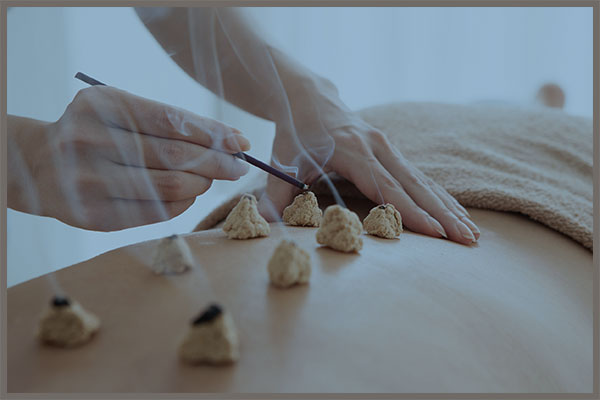
يقول الزهراوي: الفصل الثامن والأربعون في كيّ الخدر متى خدر عضو من الأعضاء وعولج بالأدوية والأدهان والضمادات فلم يبرأ، فاكوِ نفس العضو المخدور كيات على حسب ما يستحق عِظَم العضو وصغره، وليكن كيك واغلاً في ثخن الجلد قليلاً ثم تعالجه بالمرهم حتى يبرأ، وقد يكوى لبعض الخدر الذي يعرض لليد والرجل، في فقارات الظهر عند مخرج العصب الذي يحرك ذلك العضو، فيذهب الخدر، ولا يقدم على ذلك إلا من كان بصيراً بتشريح الأعضاء ومخارج الأعصاب المحركة للبدن إن شاء الله.
الجهاز العصبي يوجه وينسق جميع أعضاء وأجهزة الإنسان ، ومن المعلوم أن كل فقرة من فقرات العمود الفقري يخرج منها زوج " حزمة " من الأعصاب ، والجدول أدناه يبين مناطق خروج الأعصاب وتأثيرها على أعضاء الجسم ، ويمكن الاستفادة من هذا الجدول في وضع المحاجم في المكان المناسب وكذلك مواضع الكي .

التأثيـرات
|
الفقرات
|
المناطـــق
|
الفقرات العنقية
|
||
|
صداع
، توتر ، أرق ، نزلة
برد رأسية ، ارتفاع ضغط الدم، صداع الشقيقة، انهيار عصبي ، فقدان الذاكرة، إعياء مزمن ، دوار |
1
|
مورد الدم الى الرأس ، الغدة النخامية النخامية ، فروة الرأس ، عظام
الوجه ، الدماغ ، الأذن الداخلية والوسطى ،الجهاز
العصبي السميتاوي (الودي ). |
|
مشاكل الجيوب لأنفية ،حساسية
، حول ، صمم،مشاكل العينين ، وجع الأذن ، شعور بالإغماء ، حالات عمى معينة . |
2 |
العينان
، أعصاب العينين ،
أعصاب السمع ، الجيوب ، عظم االخشاء وراء الأذن ،
اللسان ، الجبين |
|
النورجا( ألم عصب ) ، التهاب
عصبي ، حب الشباب أو البثور ، اكزيما . |
3 |
الوجنتان
، الأذن الخارجية ،
عظام الوجه ، الأسنان ، العصب المثلث ، الوجه. |
|
حمى القش ، التهاب القناة التنفسية ، فقد السمع ، الزوائد الأنفية |
4 |
الأنف
، الشفتان ، الفم ،
القناة السمعية . |
|
التهاب الحنجرة ، البحة ، أمراض الحلق ، التهاب اللوزتين التقرحي . |
5 |
حبال الصوت ، غدد العنق ، البلعوم . |
|
رقبة متصلبة ، ألم في أعلى الذراع ، التهاب اللوزتين ، السعال الديكي ،الخناق |
6 |
العنق
، العضلات ، الكتفان
، اللوزتان . |
|
زكام ونزلات ، أمراض درقية |
7 |
الغدة الدرقية ، أكياس مصلية في الكتفين والمرفقين . |
|
الفقرات الصدرية |
||
|
الربو
، السعال ، صعوبة
التنفس ، ضيق النفس ، ألم في اسفل الذراع واليد. |
1 |
الذراعان من المرفق
فنازلاً بما في ذلك اليد والرسغ والأصابع والمرئ والرغامي ( القصبة الهوائية ). |
|
أمراض في وظائف القلب ، علل صدرية . |
2 |
القلب وصماماته ، شراين القلب.
|
|
التهاب شعب التنفس ، ذات الجنب ، ذات الرئة ، احتقان ، انفلونزا. |
3 |
الرئتان
، الأنابيب الشعبية ،
غشاء الجنب ، الصدر ، الثدي . |
|
أمراض المرارة ، اليرقان ، القوبا
المنطقية . |
4 |
المرارة
، القناة المشتركة . |
|
أمراض الكبد ، حميات ، انخفاض ضغط الدم ، دورة ضعيفة ، التهاب
مفاصل . |
5 |
الكبد
، الضفيرة الشمسية
،الدم |
|
أمراض المعدة : عسر الهضم ، سوء الهضم ، حرقة فم المعدة . |
6 |
المعدة |
|
قروح
، التهاب فم المعدة |
7 |
البنكرياس
، المعي الاثنا عشري. |
|
مقاومة متدنية |
8 |
الطحال
. |
|
حساسيات
، شر ( طفح جلدي ) |
9 |
الغدتان الكضريتان فوق الكليتين. |
|
أمراض الكليتين،
تصلب الشرايين ، إعياء مزمن ، التهاب الكلية ، التهاب حويضة الكلية. |
10 |
الكلياتان . |
|
أمراض جلدية كحب
الشباب والبثور والأكزيما والبواسير. |
11 |
الكليتان
، الحالب |
|
روماتيزم
، آلام الغازات ، انواع من العقم . |
12 |
المعي الغليظ ، الدوران اللمفي . |
الفقرات القطنية
|
||
|
عسر الهضم ، التهاب غشاء القولون المخاطي،الزحار،الإسهال،بعض
التمزق والفتوق. |
1 |
المعي
الدقيق ، حلقات الأربية . |
|
صعوبة التنفس ، الحماض ( انخفاض قلوية
الدم والأنسجة )، الأوردة الدالية . |
2 |
الزائدة الدودية ، البطن، أعلى الرجل |
|
أمراض المثانة ، مشاكل الحيض ، الإسقاط والإجهاض ، التبليل في الفراش ، العنة ، تغير عوارض الحياة ن آلام
الركبة . |
3 |
الأعضاء التناسلية ، الرحم ، المثانة ، الركبة .
|
|
عرق النسا ، اللمباغو ( الم عصبي في
أسفل الظهر ، تبول متعسر ، أو متكرر ، أو مؤلم ، ألم الظهر . |
4 |
غدة البروستات ،
عضلات أسفل الظهر ، عرق النسا . |
|
دوران ضعيف في الساقين ، انتفاخ رسغي القدمين ، قدمان باردتان ، ضعف في
الساقين ، عقال الساقين. |
5 |
الساقان
، رسغا الساقين ،
القدمان . |
|
آلام اتصال العجز والحرقفية ،
حنايا في العمود الفقري. |
العجز |
عظم الورك ، الردفان . |
|
البواسير، الحكة،
ألم في طرف العمود الفقري عند الجلوس
. |
العصعص |
المستقيم
، الشرج . |
الجدول منقول من كتاب دليل البدائل الطبية للدكتورة
سامية حمزة عزام .
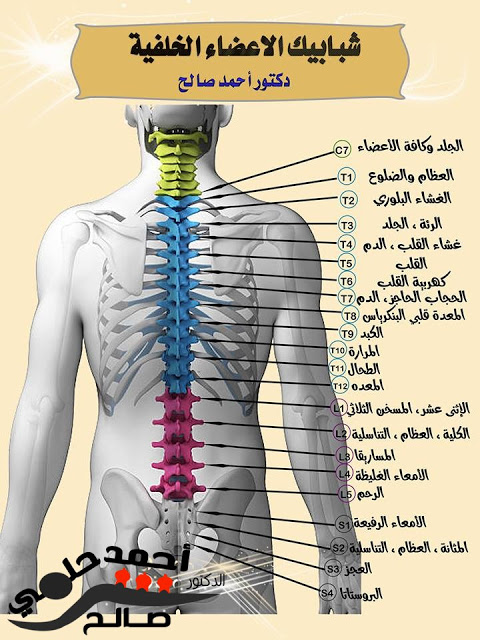

شبابيك الاعضاء طريقك نحو علاج فعال
امسية علمية على مجموعة النخبة للطب التكميلي من
تقديم:-
د.احمد
حلمي صالح
*هي اطلاله عظيمه تبدأ من الجلد( من الفقره
وشباكها الخارجي) الى العضو الداخلي الذي يمثلها في حالة استخدامنا للشبابيك
الظهرية ،والتأثير فيه بحسب الهجره الجنينيه للاعضاء من الظهر الى مواقعها ،
وترك شباك مطل عليها من الظهر الى الداخل .
*وهناك الشبابيك
التشريحيه الامامية ،وهي تقع من الامام وتمثل الشباك التشريحي للعضو داخليا.
*وان انت احسنت اختيار
النقطه العلاجيه، وذلك بإختيارك للفقره التابعه للوظيفه( التي تريد التأثير
فيها) ،فقد قطعت مشوارا كبيرا جدا في العلاج ....،اما ابتعادك عن النقطه بمقدار
2 مل او 3 مل قد يؤدي الى فشل كامل في المقصد العلاجي المطلوب.
*وليست العبره بكثرة
الكؤوس او امتلاء الظهر من اوله لآخره بها... وانما
العبره بتشخيص المشكله المرضيه، واختيار المكان الامثل ،والعمل عليه( بالتأثير
العلاجي المناسب للحاله).
*وان تكون نقطة العلاج
في (منتصف) وسيلة التأثير، فإن كانت الوسيله ابره ،فلابد ان تكون على النقطه
مباشرة ،وان كانت كأس حجامه ، فإن النقطه لابد ان تكون في منتصفه تماما .
*وبعض النقاط لها خواص
علاجية تتأثر و تختلف باختلاف طرق العلاج ، فتكون لكل طريقه تأثير مغاير لطريقة
اخرى .
مثال لذلك
النقطة Du2. او قمة الرأس ،او 32 شيخ الحجامين .
فإننا ان قمنا بالتأثير عليها بالتدليك فإنها
تساعد في رفع ضغط الدم المنخفض .
وان قمنا بالتأثير
عليها بالحجامه الدمويه، فإنها تساعد في خفض ضغط الدم المرتفع .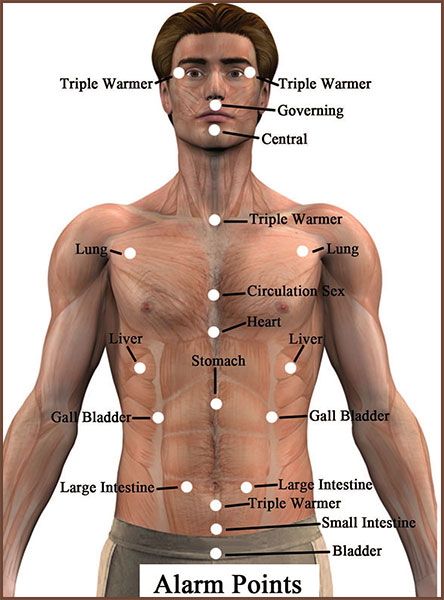
وان قمنا بالتأثير
عليها بالموكسا ، فإنها تساعد في في علاج البواسير أوهبوط الرحم .
*هذا ووجدت مدااارس
عديده في تأصيل علم النقاط ،كانت اشملهم مدرسة( الطب الصيني التقليدي) .
كما يوجد مدارس عربيه
مثل مدرسة شيخ الحجامين (احمد حفني حفظه الله) .
ثم باقي المدارس الاخرى مثل تقنين مدرسة د.محمود
شعراوي
وتقنين
مدرسة د.امجد هزاع....وغيرهم .
*ومع تعدد المدارس ،قد
يحتاج الانسان الى مدرسه بسيطه سهلة المعرفه وسهلة العلاج .
هذه المدرسة أصل لها منذ سنين (د.هاني الغزاوي)
عبر علاج مناطق رؤية الاعضاء على الظهر ،حيث انها
نقاط( مفتاحيه) اي انها تشخيصيه وعلاجية في آن
واحد .
نقاط
(الظهر ) Back shu points
ونقاط( الامام) Front fu points
المتصله اتصالا وثيقآ بأمراض أعضاء زانج فو
،،،وعندما يطرأ تغيير مرضي على احد اعضاء زانج فو ...فإن رد الفعل الايجابي
لهذا التغير سواءا اكان ليونه او حساسيه ،بالامكان اكتشافها في نقطة الشباك
الظهري او الامامي (كرد فعل انعكاسي خارجي )للمشكله الداخليه للعضو ... ولذلك
يطلق على هذه النقاط (بالنقاط
المنبهه) ، وهذا يعني انه كلما تأثر احد
الاعضاء الداخليه فإن نقطة الظهر والامام المتصلتان بالعضو بالامكان النصح
(بمعالجتهما معآ).
______________________________________
النقاط فيما يتعلق بترتيب العضو وزوجه ، وكذلك
الرمز الظهري للفقره المسئوله عن الوظيفه .
________________________________
نبدأ من نقطة الظهر ثم
النقطه الاماميه .
الرئه T3= المثانه 13Bl او Ub13
ومن الامام= الرئه Lu 1
........................................
الامعاء الغليظه L4 = مثانه25Ub
ومن الامام= المعده St25
.........................................
غلاف القلب T4 او غشاؤه=مثانه14
ومن الامام =رن Ren17
.........................................
سان جاو L1=مثانه 22 Ub
ومن الامام= رن5 Ren
.........................................
القلبT5=مثانه Ub 15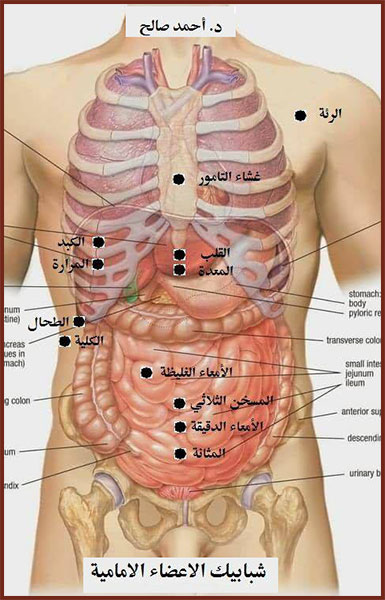
ومن الامام =رن 14 Ren
.........................................
الامعاء الدقيقهS1=مثانهub27
ومن الامام=رن4 Ren
.........................................
الكبد T9 = مثانه 18 Ub
ومن الامام=كبد 14 LV
.........................................
المرارهT1.= مثانه19 Ub
ومن الامام= مراره GB 24
.........................................
الطحال T11 =مثانه 2. Ub
ومن الامام=كبد 13 Lv
.........................................
المعده T12=مثانه21 Ub
ومن الامام رن 25 Ren
.........................................
الكليهL2=مثانه23 Ub
ومن الامام =مراره 25 Gb
.........................................
المثانه البوليه S2 =المثانه28 Ub
ومن الامام =رن 3 Ren
.........................................
وللحديث بقيه
شبابيك الاعضاء طريقك نحو علاج فعال.
تفريغ وتنسيق :أسماء
آلغباشي.
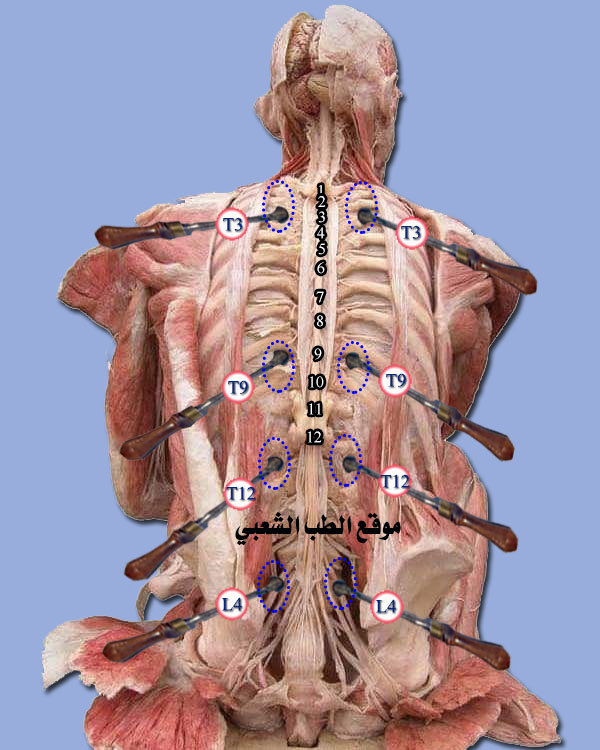
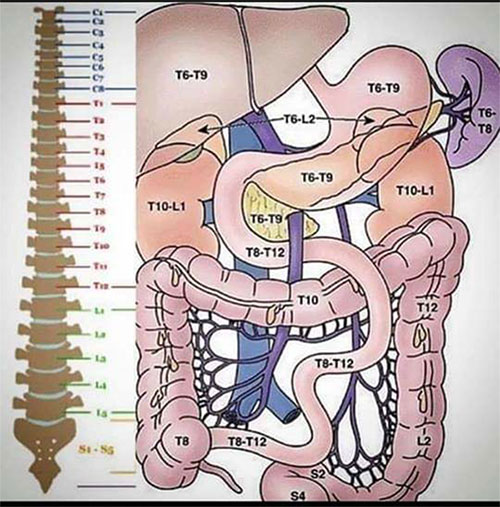
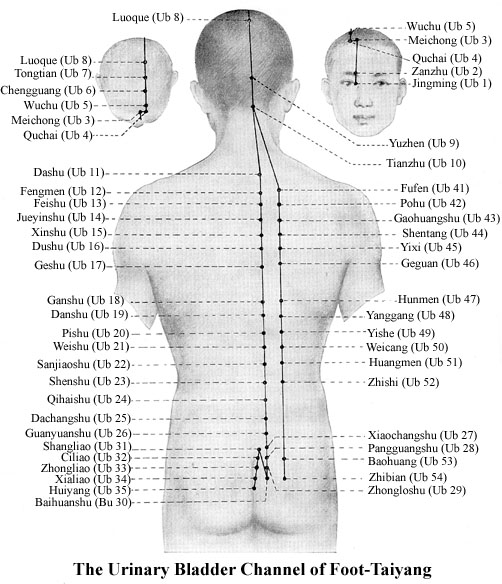
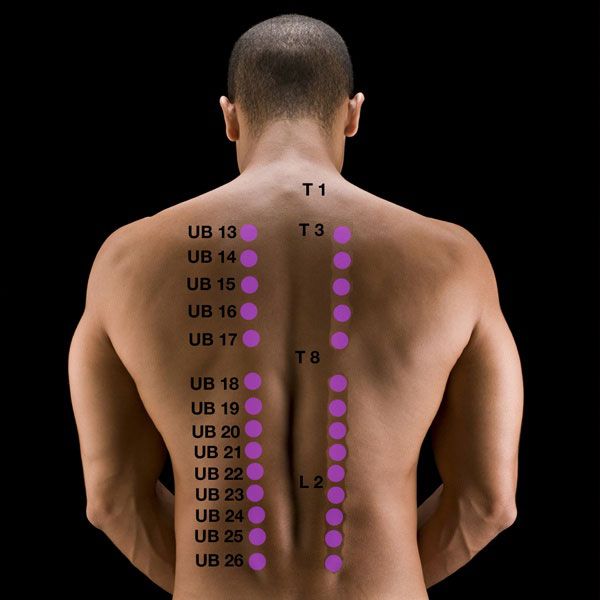

Front
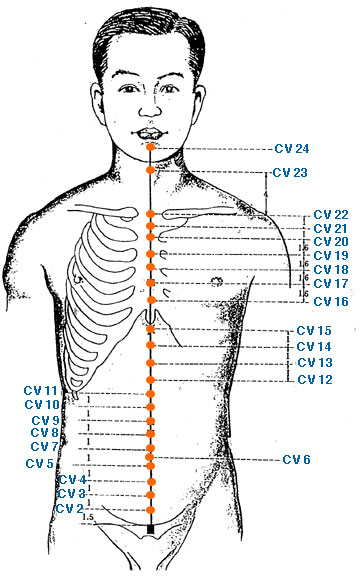
CV 5 Acupuncture Point
English Name: Stone Gate
Pinyin Name:
Shi Men
Chinese Character: 石門
Location:3 cun above CV 2 (pubic
symphysis).
CV 5 Clinical Usages
Generally, useful for patterns of
excess involving the lower abdomen a/or urinary tracts. Not used as often as
other CV points.
Mentioned classically to both cause and treat
infertility, although the cause may merely be incorrect needling which is
specifically mentioned. Modern texts have largely ignored these cautions.
Useful for lower abdominal pain of an excess nature, genital pain/itching,
shan disorders, hernia.
Diarrhea, undigested food in stools, poor
appetite, abdominal pain, edema.
English Name: Sea of Qi
Pinyin Name:
Qi Hai
Chinese Character: 氣海
Location:Midway between CV 5 and CV 7,
1.5 cun below CV 8 (umbilicus).
CV 6 Clinical Usages
Generally, useful
for Qi tonification.
Women's health - hernia, uterine bleeding, irregular
menstruation, dysmenorrhea (painful menstruation / cramps), amenorrhea,
leukorrhea.
Men's health - impotence, seminal emission, nighttime
urinartion, hernia.
Deficiencies of the lower and middle warmers -
abdominal distention, bloating, edema, poor digestion, loose stools,
diarrhea, fatigue.
Tonify ST/SP Qi Deficiencies.
Main point for
prolapse of any type - rectum, uterus, etc. Lower abdominal and/or genital
pain / swelling.
Stroke, loss of consciousness, weakness of the muscles
and body generally.
Tong Ren/Tam Healing System: Main point for building
and storing Qi (energy), useful for deficiency conditions - asthma,
shortness of breath, general fatigue, etc.
English Name: Central Venter
Pinyin Name: Zhong Wan
Chinese Character:
中脘
Location: Midway between CV 8 and CV 16, 4 cun above CV 8
(umbilicus).
CV 12 Clinical Usages
CV 12 is useful for middle warmer
issues, whereas CV 10 is useful for lower warmer issues and CV 13 is useful
for upper warmer issues.
ST patterns arising from an excess or a
deficiency, tonify deficient SP patterns (moxa useful) - nearly all
digestive issues - pain, bloating, reflux, vomiting, diarrhea, jaundice.
Hui Meeting Point - broad effect on the Fu (hollow) organs in the body.
Stress related digestive disorders (nervous Stomach, heartburn, diarrhea)
along with various symptoms such as insomnia, anxiety, etc. particularly
from worry and/or overthinking..
Tong Ren/Tam Healing System: Used for
all digestive issues and esophagus issues, also useful for weight loss.
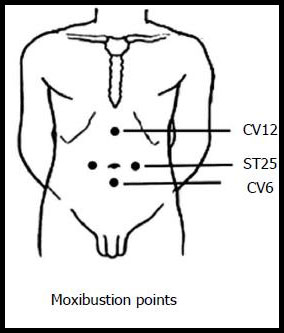
ST 25 Acupuncture Point
English Name: Celestial Pivot
Pinyin Name: Tianshu
Chinese Character: 天樞
Location: 2 cun lateral to
the AML level with CV 8.
ST 25 Clinical Usages
All intestinal issues - constipation, diarrhea,
dysentary, distention, pain, masses/accumulations of any type.
Irregular
menstruation, painful menstruation, fibroids/cysts, fertility issues and
leukorrhea.
Connects the Upper and Lower Warmers (pre & post natal Qi).
English Name: Great Hammer
Pinyin Name: Da Zhui
Chinese Character: 大椎
GV 14 Location = C7.
Meeting
point of all yang meridians, GV 14 is indicated for exterior conditions as
it expels pathogens and firms the yang; clearing heat and fevers whether
mild or severe; and for tonifying the yang and strengthening the neck and
spine.
Main point for acute wind cold or wind heat, colds and flu,
especially with fever and chills, opens the pores to cause sweating. If a
patient with underlying deficiency presents with chills and no fever use
moxa.
Main point for reducing high fevers, combine with LU 11, UB 40 (can
bleed these points). Main point for summer heat.
Cough, asthma.
Main
point for spontaneous sweating from qi deficiency or night sweats from yin
deficiency.
Main point for neck and upper back pain and stiffness,
combine with GB 20, UB 10, UB 11, UB 12, Bailao, SI 12, SI 13, etc. As the
tissue is often thick here, insert slowly and use mild manipulation, then
redirect needle towards each shoulder using oblique insertion.
Strengthens the wei qi, wind cold can enter the body through the triangle
formed by GV 14 and UB 12. Keep this area warm, supple and flexible with
needle, moxa, massage to promote longevity.
Epilepsy, hypertension,
insomnia, nosebleed.
Tong Ren/Tam Healing System: Used for bone issues
(arthritis, spurs, scoliosis), calcium issues, hand issues.
English Name: Great Shuttle
Pinyin Name: Da Zhu
Chinese Character: 大杼
Location: 1.5 cun lateral to
GV 13, level with T1.
For point location tips, read our meridian notes; unsure about "cun"
measurements, read what is a cun?.
UB
11 Clinical Usages
Wind disorders.
Hui-meeting point of the bones, useful with any bone or problem such as
osteoporosis, arthritis, inflammation, sensation of heat in the bones, etc.
Useful adjunctive point to effect the lungs in cases of infections, colds
a/or flus or asthma related conditions.
Sea of Blood Point with ST 37 &
ST 39. According to the Ling Shu Treatise on the Seas, "when the Sea of
blood is full, the patient has the sensation that his body is bigger than it
is. One feels uneasy, and does not know the disease; when the Sea of blood
is insufficient, one often feels the body is small, one feels uneasy and
does not know the disease." May be useful for leukemia, anemia, said to
tonify the bone marrow.
English Name: Lung Shu
Pinyin Name: Fei Shu
Chinese
Character: 肺俞
Location: 1.5 cun lateral to GV 12, level with
T3.
UB 13 Clinical Usages
Main point for
all Lung related issues from a TCM perspective - tonifies LU Qi and Yin:
cough, asthma, bronchitis, sore throat, nasal congestion, shortness of
breath, weakness of the voice, consumption, steaming bone disorder, etc.
Useful for skin disorders, itching, acne, hives, etc.
Lung related
emotional imbalances such as grief and sadness.
Qi tonification aspects
can be increased with the application of moxabustion at this point.
UB 14 Acupuncture Point
English Name: Jue Yin Shu (Pericardium Shu)
Pinyin Name: Jue Yin Shu
Chinese Character: 厥陰俞
Location: 1.5 cun lateral to the GV line, level
with T4.
UB 14 Clinical Usages
For all heart
conditions: palpitations, anxiety, stress, etc. Combine with PC 6 to open
the chest (as in the case of plum pit qi). This chest pain can be
psycho-emotional (i.e. liver/heart system related in Chinese Medicine
terms), or it may be from simple congestion (cough, rebellious qi, shortness
of breath, etc.).
Harmonizes the liver - as the "Jueyin Shu" you may also
treat LV related conditions such as stagnation of LV Qi - depression,
anxiety, panic attacks, etc.
UB 15 Acupuncture Point
English Name: Heart Shu
Pinyin Name: Xin Shu
Chinese Character: 心俞
Location: 1.5 cun lateral to GV 11, level with
T5.
UB 15 Clinical
Usages
Main point for all heart related issues from a TCM
perspective, blood and circulatory related issues of an excess or deficient
nature.
Nourishes the spirit and calms the shen - main point for all
heart related emotional issues: palpitations, anxiety, easily frightened
(ht/kd), stress, poor memory. Useful with PC 6, HT 7, CV 14 a/or UB 14.
Particularly important point for insomnia.
Night sweats in Heart Qi a/or
Yin deficiency.
UB 17 Acupuncture Point
English Name: Diaphragm Shu
Pinyin Name: Ge Shu
Chinese Character: 膈俞
Location:1.5 cun lateral to GV 9, level with
T7.
UB 17 Clinical Usages
Hui-meeting Point of the Blood, useful for all Blood related conditions.
Classically combined with UB 19 to create the "Four Flowers" which is used
to nourish the Blood, although in clinical practice UB 18 & UB 19 may used
equally as often. These conditions may include coughing or vomiting of
blood, blood in the stool.
For menstrual problems, from deficiency
(scanty, light periods, amenorrhea) or stasis (dark clots, dysmenorrhea).
Important point for red, itchy skin disorders, from heat in the Blood:
eczema, carbuncles.
As the "Diaphgram shu" it harmonizes the chest and
descends rebellious qi - problems with diaphragmatic breathing or shortness
of breath and other diaphragm related conditions such as belching or hiatal
hernia.
Chest / cardiac pain, also psychological "heart" related
conditions - manic depression.
A range of digestive issues, particularly
those involving rebellious qi - vomiting, epigastric pain, reflux.
UB 18 Acupuncture Point
English Name: Liver Shu
Pinyin Name: Gan Shu
Chinese
Character: 肝俞
Location:1.5 cun lateral to GV 8, level with
T9.
UB 18 Clinical Usages
Main point for
all Liver related conditions in TCM terms - physical and psycho-emotional.
Physical liver issues such as - hepatitis, jaundice, cirrhosis. Generalized
blood stagnation, qi stagnation, etc.
Brightens the eyes - important
point for eye problems, pain, itching, dryness, redness, blurred vision,
visual dizziness, twitching, night blindness.
Spreads liver qi and
stablizes the spirit - important point for LV related emotional issues such
as anger, depression, irritability, frustration, stress a/or PMS.
Useful
for hypochondriac a/or subcostal pain/distention.
UB 19 Acupuncture Point
English Name: Gallbladder Shu
Pinyin Name: Dan Shu
Chinese
Character: 膽俞
Location:1.5 cun lateral to GV 7, level with
T10.
UB 19 Clinical Usages
Shao Yang level
diseases, alternating fever and chills.
Main point for damp heat in the
Liver and Gall Bladder: hepatitis, cholecystitis, jaundice, vomiting, flank
pain and distension, bitter taste in the mouth. Often combined with the LV
Shu (UB 18).
UB 17 & UB 19 are classcially known as the "Four Flowers,"
useful for tonifying the Blood.
Pain along the GB meridian (sides of the
body) from any etiology, intercostal neuralgia, rib pain, trauma, herpes
zoster.
Gall Bladder related emotional issues: indecision, timidity,
fear. As well as damp-heat related psycho-emotional issues such as insomnia,
anxiety (often with bitter taste in the mouth), palpitations.
UB 20 Acupuncture Point
English Name: Spleen Shu
Pinyin Name: Pi Shu
Chinese
Character: 脾俞
Location: 1.5 cun lateral to GV 6, level with
T11.
UB 20 Clinical Usages
Main point for
all Spleen problems from a TCM perspective of both the physical organ
functions and the energetic/psychological relationships.
Physical spleen
issues - distention, abdominal pain, bloating, poor appetite along with more
involved conditions - dysentary, malarial diseases.
Blood related
conditions - heavy menstrual bleeding, uterine bleeding, blood in the stools
and/or urine.
Commonly used for SP Qi Deficiency: fatigue (can be heavy,
spreading through the limbs/heaviness), lack of appetite, abdominal bloating
a/or distention, undigested food in the stools, chronic diarrhea a/or
belching.
UB 21 Acupuncture Point
English Name: Stomach Shu
Pinyin Name: Wei Shu
Chinese
Character: 胃俞
Location:1.5 cun lateral to GV line, level with
T12.
UB 21 Clinical Usages
Main point for
all Stomach related issues in TCM diagnostic terms - harmonizes the stomach,
transforms damp and resolves stagnation: food stagnation, abdominal
distention, borborygmus, mouth ulcers, vomiting, belching, nausea, etc.
Dissolve accumulations/lumps in the abdomen, combine with Pigen (point for
lumps, tumors), 3.5 cun lateral to the lower border of L1. Due to the same
qi stagnation resolving functions it may also be useful for pain in the
chest, stomach/spleen area and lateral costal margin area.
As the point
also regulates the upward rising qi functions, it is used for prolapse of
the rectum and uses with other points for hiatal hernias.
UB 22 Acupuncture Point
English Name: Triple Burner Shu
Pinyin Name: San Jiao Shu
Chinese Character: 三焦俞
Location: 1.5 cun lateral to GV 5, level with
L1.
UB 22 Clinical Usages
As Triple Heater
Shu this point effects conditions related to imbalances between the upper
and lower parts of the body especially those related to water: edema,
bloating, ascites, borborygmus, difficult or painful urination, urinary
retention.
With its ability to move water accumulations also useful for
certain damp related issues in the head such as headaches and visual
dizziness.
Uses with alternating chills and fever, jaundice and other
issues involving difficulty digesting foods.
English Name: Kidney Shu
Pinyin Name: Shen Shu
Chinese
Character: 腎俞
Location:1.5 cun lateral to GV 4, level with
L2.
UB 23 Clinical Usages
For all Kidney system related issues from a Chinese Medicine perspective
which effect the brain, bone, hair, teeth a/or hearing.
Male deficiency
related sexual problems: impotence, premature ejaculation, spermatorrhea,
sterility, exhaustion following ejaculation.
Female sexual and
reproductive disorders: irregular cycles, dysmenorrhea, amenorrhea, cold
uterus, frigidity, infertility, leukorrhea.
Tonification point in
deficiency conditions: exhaustion, weakness, chronic fatique, good point for
the elderly as Kidney Jing is naturally depleted.
Main point for acute or
chronic low back pain, sprains a/or strains.
Useful for KD related ear
issues: tinnitus, deafness, chronic ear infections.
Useful for dampness
issues and water metabolism issues - edema, fluid retentions in the lower
abdomen.
As the kidney system provides the root of the bodies energy many
psychological conditions will respond well to tonification of this point as
well - depression, anxiety disorders.
English Name: Large Intestine Shu
Pinyin Name: Da Chang Shu
Chinese Character: 大腸俞
Location: 1.5 cun lateral to GV 3,
level with L4
Main point
for low back pain especially when related to constipation a/or menstruation.
Combine with local points such as GV 3, UB 26, Shiqizhui (between L5 and
S1), UB 31, UB 32, GB 30 & distal points such as GB 34, GB 39, GB 41, UB 40,
UB 57, UB 58, UB 60 & UB 62.
Main point for all intestine related issues:
constipation, diarrhea, dysentery, colitis, IBS, etc.
Regulates the
function in the colon so as potential uses for poor assimilation, limited
weight gain despite eating many calories.
English Name: Small Intestine Shu
Pinyin Name: Xiao Chang Shu
Chinese Character: 小腸俞
Location:1.5 cun lateral to GV line,
level with 1st PSF.
UB 27 Clinical Usages
Main point for
all Small Intestine related issues.
Damp heat effecting the bladder
(difficult or painful urination, hematuria, dark urine).
Damp heat
effecting the intestines (diarrhea, hemorrhoids, dysentary).
Other lower
warmer discharges - leukorrhea, seminal emission
English Name: Bladder Shu
Pinyin Name: Pang Guang Shu
Chinese
Character: 膀胱俞
Location:1.5 cun lateral to GV line, level with
2nd PSF.
UB 28 Clinical Usages
Main point for
all Bladder issues: from damp heat (painful a/or dark urination), from cold
(frequent urination, incontinence)
For damp-heat anywhere in the body,
combine with SP 9 to expel dampness through urination - diarrhea,
constipation, sore back, infections and/or swellings in the lower warmer..

-
في حالة نسخ أي صفحة من صفحات هذا الموقع الرجاء ذكر المصدر على النحو التالي
-
نقلا عن موقع الطب الشعبي
